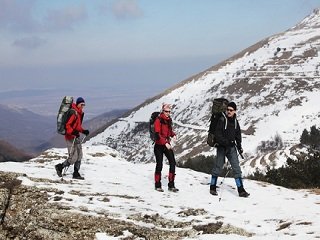 Layering is a crucial part of enjoying the outdoors during the colder winter months and knowing what makes an effective base, mid, and outer layer will help better prepare you for those winter hikes. The outer layer, or shell, is your first line of defense against the elements and choosing a quality jacket is an important task. Today, I’ve broken down the various qualities found among the modern selection of shell layers in order to help you better decide which one is right for you.
Layering is a crucial part of enjoying the outdoors during the colder winter months and knowing what makes an effective base, mid, and outer layer will help better prepare you for those winter hikes. The outer layer, or shell, is your first line of defense against the elements and choosing a quality jacket is an important task. Today, I’ve broken down the various qualities found among the modern selection of shell layers in order to help you better decide which one is right for you.
Waterproof, breathable shells tend to be the most functional choice, but also the most expensive. These shells are best for wet, cool conditions and alpine activities. Shells using laminated membranes such as Gore-Tex offer top performance in terms of waterproofing, while those that utilize fabric coatings are a more economical alternative. Waterproof shells are usually defined as either rainwear, which emphasizes low weight and packability, or mountaineering wear, which is more durable and has additional features.
There are also waterproof, non-breathable shells are ideal for rainy days with light activity, such as fishing or trips downtown. They are typically made of a sturdy, polyurethane-coated nylon, which is both waterproof and windproof.
Water-resistant, breathable shells are best for light precipitation and high activity levels, but won’t hold up to consistent rain and snow as well as fully waterproof products. They’re less expensive than waterproof/breathable shells and are usually made of tightly woven fabrics, such as ripstop nylon, in order to block wind and light rain.
Lastly, there are soft shells, which come in a variety of options to suit both cold and mild weather needs. Soft shells emphasize breathability and most of them feature stretch fabric or fabric panels for added comfort during aerobic activities. Many offer not only shell properties, but insulation properties, as well.
With so many outer shell layers to choose from, you’ll definitely want to factor in how often you’ll be hitting the trails this winter, as well as the weather for your region. Areas where winter is usually mild most likely won’t require large, heavy-duty coat, for instance. You also don’t want to spend a ton of money on something you won’t need or won’t wear very often. Enjoy your winter, fellow outdoorsmen, but do so safely and warmly, and perhaps I’ll see you out on the trail sometime!








